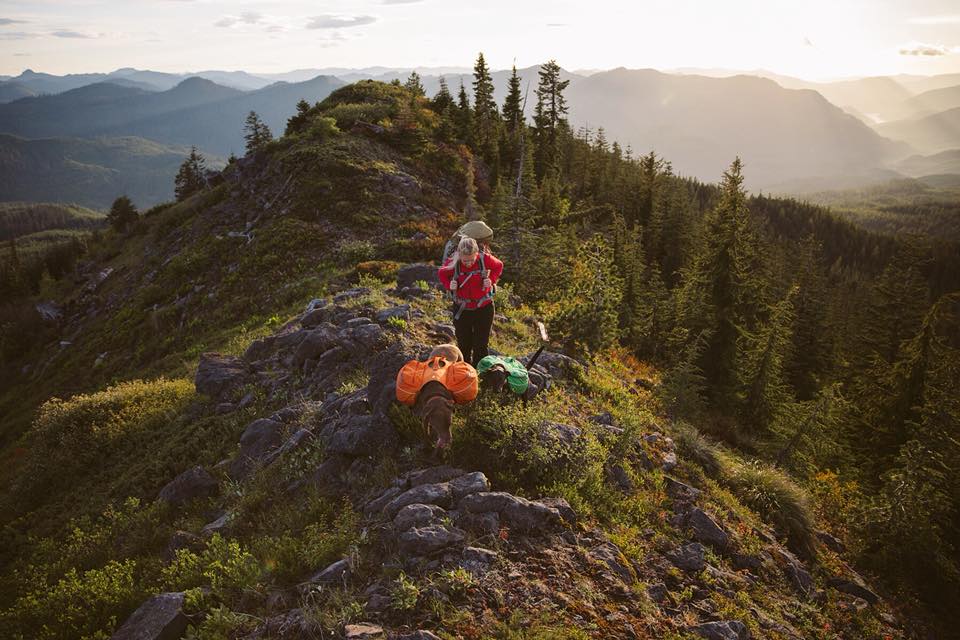There is nothing like packing your backpack, grabbing a leash, and heading out into the great outdoors with your best friend. There is so much to sniff and see, and it’s fun and good exercise for both of you. However, before you hit the trails with your pup, think about how to lessen your impact on places you’re visiting, and to have a safe and fun experience.
You know your dog best. If your dog is nervous, anxious, or aggressive, or does not behave well in new situations, consider these factors when bringing them on adventures. The hike should be enjoyable for everyone: you, your pup, the people and pets sharing the spaces around you…and the wildlife that live here!

1. Follow Leave No Trace Tips for Dogs
It’s safe to say no hiker enjoys coming across a pile of dog poop when they step into the Adirondack backcountry. So, make sure to bring bags to collect and carry out your pet waste. As well, don’t allow your animal to chase wildlife, keep them on the trail and off vegetation, and follow other LNT principles concerning dogs.
2. Be considerate of everyone on the trails
The New York Department of Environmental Conservation asks dog owners to keep their pets under control on Forest Preserve lands, and other agencies have similar guidelines. The best way to do this is through proper training or simply keeping your dog on a leash 100 percent of the time. When a group approaches, leash your dog, and step to the side to let them pass. Ask other visitors on the trail if your dog can say hello before assuming it’s okay for them to approach. Not every human or dog on the trails loves dogs, so it’s always important to ask.

3. Know the rules for everywhere you go
Each activity in the Adirondacks has its own set of rules. For instance, the High Peaks Wilderness Area has certain leash rules. On some trails on private land, such as Indian Head and Rainbow Falls, dogs are not allowed at all. On other trails, dogs must be leashed at all times. Check online for rules and regulations before you go.
4. Think about your dog’s needs
Being outside is about having fun. When you’re heading out on an adventure, it’s important to put your dog’s comfort level first. Plan your trip around your dog’s interests, age, ability, and energy levels. Research activities beforehand, so there are no unexpected rock scrambles or water crossings. And, be fully ready to turn around if your dog isn’t having fun. During your journey, look for signs of dehydration, heat exhaustion, hypothermia, and pain…and take breaks often.

5. Wear the right gear
Especially during hunting season, many trails are shared by a variety of outdoor enthusiasts. In response, it’s important that your dog stays visible to other people and animals in the Adirondacks. Your dog should wear a reflective collar, bright bandana, or harness that can be spotted from afar. Some dog owners that hike deep into the Adirondacks also prefer their pet wear a bell on their collar, so they can be heard by humans and wildlife. Additionally, there are cooling vests, insulated warming “jackets,” booties, and life jackets made for dogs that may also be helpful.
6. Safety isn’t just for humans
Bring an extra water bottle and healthy treats for your dog. Use a portable water bowl or reuse a plastic container to give your dog water frequently. Carry a small first-aid kit that includes materials you can use to administer first aid if your pup gets injured. The Humane Society recommends a few essential items for pet first aid. Additionally, tick-borne diseases are a real threat in the Adirondacks, so talk with your vet about the best flea and tick prevention options for your pet.
7. Think about your post-adventure hangs
Many restaurants, shops, breweries, campgrounds, and lodging options in the Adirondacks are dog-friendly. Still, call ahead to make sure that any place where you’ll grab a bite to eat and rest your feet can also accommodate your dog. New York State law prohibits the confinement of an animal in a motor vehicle in extreme temperatures, so avoid leaving your pooch in the car.
Mary Godnick
Mary grew up just outside the Blue Line but now calls the Adirondacks home. She is now the Marketing and Development Assistant at the Adirondack Council—the largest conservation advocacy organization dedicated to the Adirondack Park. The Council is an independent, privately funded, not-for-profit organization with a mission to ensure the ecological integrity and wild character of the Adirondack Park through research, education, advocacy and legal action. She loves spending time in her vegetable garden, volunteering at the SPCA, doing yoga, hiking, scuba diving, and camping.
Related Posts
April 2, 2024
10 Tips for Mountain Biking Etiquette During Mud Season
One rough spring could ruin the…




